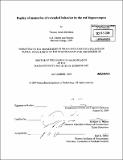| dc.contributor.advisor | Matthew Wilson. | en_US |
| dc.contributor.author | Davidson, Thomas James Damon Cheakamus | en_US |
| dc.contributor.other | Massachusetts Institute of Technology. Dept. of Brain and Cognitive Sciences. | en_US |
| dc.date.accessioned | 2010-04-28T17:10:54Z | |
| dc.date.available | 2010-04-28T17:10:54Z | |
| dc.date.copyright | 2009 | en_US |
| dc.date.issued | 2009 | en_US |
| dc.identifier.uri | http://hdl.handle.net/1721.1/54622 | |
| dc.description | Thesis (Ph. D.)--Massachusetts Institute of Technology, Dept. of Brain and Cognitive Sciences, 2009. | en_US |
| dc.description | Cataloged from PDF version of thesis. | en_US |
| dc.description | Includes bibliographical references. | en_US |
| dc.description.abstract | The hippocampus is a highly conserved structure in the medial temporal lobe of the brain that is known to be critical for spatial learning in rodents, and spatial and episodic memory in humans. During pauses in exploration, ensembles of place cells in the rat hippocampus re-express firing sequences corresponding to recent spatial experience. Such 'replay' co-occurs with ripple events: short-lasting (~50-120 ms), high frequency (-200 Hz) oscillations that are associated with increased hippocampal-cortical communication. In previous studies, rats explored small environments, and replay was found to be anchored to the rat's current location, and compressed in time such that replay of the complete environment occurred during a single ripple event. In this thesis, we develop a probabilistic neural decoding approach that allows us to show that firing sequences corresponding to long runs through a large environment are replayed with high fidelity (in both forward and reverse order). We show that such replay can begin at remote locations on the track, and proceeds at a characteristic virtual speed of -8 m/s. Replay remains coherent across trains of sharp wave-ripple events. These results suggest that extended replay is composed of chains of shorter subsequences, which may reflect a strategy for the storage and flexible expression of memories of prolonged experience. We discuss the evidence for the operation of similar mechanisms in humans. | en_US |
| dc.description.statementofresponsibility | by Thomas James Davidson. | en_US |
| dc.format.extent | 137 p. | en_US |
| dc.language.iso | eng | en_US |
| dc.publisher | Massachusetts Institute of Technology | en_US |
| dc.rights | M.I.T. theses are protected by
copyright. They may be viewed from this source for any purpose, but
reproduction or distribution in any format is prohibited without written
permission. See provided URL for inquiries about permission. | en_US |
| dc.rights.uri | http://dspace.mit.edu/handle/1721.1/7582 | en_US |
| dc.subject | Brain and Cognitive Sciences. | en_US |
| dc.title | Replay of memories of extended behavior in the rat hippocampus | en_US |
| dc.type | Thesis | en_US |
| dc.description.degree | Ph.D. | en_US |
| dc.contributor.department | Massachusetts Institute of Technology. Department of Brain and Cognitive Sciences | |
| dc.identifier.oclc | 601809026 | en_US |

